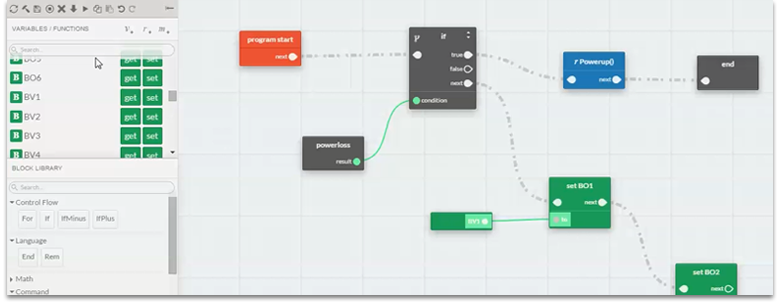
As of September 2016, KMC Controls has released block programming via the Control Basic Block editor, supported in Connect, Total Control and Niagara. The Control Basic Block editor provides a simple drag-and-drop interface to program BACnet Controllers, specifically KMC Conquest® products: BAC-5901, BAC-9001, BAC-9021, BAC-9301 & BAC-9311. By giving customers the freedom and choice to program controllers the way they want, block programming is a natural extension of KMC’s commitment to provide open, secure and scalable solutions from single-building to enterprise-level installations. But why block programming and why now?
Why Block Programming?
For many years, line-coding was the industry norm when it came to programming digitally controlled systems. It took some time to learn, but once learned, a programmer harnessed the power to build custom systems and processes fairly efficiently. As technology advanced and block programming grew in popularity, the benefits become more and more clear. Line-coding is difficult and time-consuming to learn. While block programming is still prone to human error, line-coding adds additional opportunity for syntax error such as a misplaced dot or mistaken semi-colon. Block programming handles a majority of that for you, leaving you to focus on designing the system properly.
In addition to the difficulty of line-coding, more and more talented techs are coming into the industry having never learned it. Though many if not most have had exposure to block programming. Knowing that recruiting and retaining talented employees can be a challenge, there’s no reason to add the additional road block of forcing them to learn a style of programming from scratch. Thus one of the biggest benefits of offering block programming is giving partners the choice to program as they choose.
Block Programming: KMC vs. Other Systems
There are several systems on the market that offer block programming functionality, and all of them work a little different. One of the most well-known and widely used is found in Niagara. As means of comparison, let’s explore a couple contrasts between KMC’s offering and Niagara’s.
KMC’s Control Basic Block editor and Niagara both use logical blocks and have similar folder locations. This is beneficial as it makes it simple to switch between clients’ projects that may use different systems. We’ve made it easy. Math blocks also are similar in setup and folder locations. Though once you begin to plot blocks and setup a process path, KMC’s block programming system displays an easy to follow program path with distinct connector lines. Niagara doesn’t display quite as clear of a path. Also, blocks within a family may be switched at the block (ex. And / Or / Xor / etc.) in Control Basic Block editor, where in Niagara, all blocks regardless of family are treated as separate blocks. And where Niagara focuses on detailed data real-time and granular configuration of the entire system, KMC’s solution takes a more logic-based programming approach at the controller level.
 Overall, these dissimilarities are simply a difference in philosophy: from data-driven to logic-driven and everything in between. We believe KMC’s approach allows our customers more flexibility and control. Is that better? Perhaps… but at the end of the day, we want our Partners to have freedom to choose what they like and to be as successful and efficient as possible.
Overall, these dissimilarities are simply a difference in philosophy: from data-driven to logic-driven and everything in between. We believe KMC’s approach allows our customers more flexibility and control. Is that better? Perhaps… but at the end of the day, we want our Partners to have freedom to choose what they like and to be as successful and efficient as possible.
Why now: The end of Line-Programming?
Absolutely not! Line-coding remains a fantastic, efficient way to program controllers, especially for those that have been doing it for a long time and have mastered the syntax. So, why introduce block programming now? As programming languages become more complex, tools are created to help streamline development. As mentioned before, many existing and new techs entering the industry have little experience with line-coding. For our Partners, having a solution that utilizes both line-coding and block programming opens up their possibilities in hiring talented employees that otherwise wouldn’t have been qualified. It also allows for easier cross training, as block programming can be learned easier and more quickly than straight syntax. The introduction of Control Basic Block editor to the KMC software lineup further instills our commitment to providing KMC Partners with open, secure, and scalable solutions, and as we continue to add features and enhancements to our block programming environment, we will continue to empower them to succeed and grow.
Additional Resources
Check out our four-part video series on our block programming solution.
For the latest details about block programming, see the software documentation for TotalControl, KMC Connect, or KMC Workbench.
 Cart
Cart